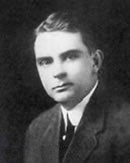Walter Dandy
| Walter E. Dandy, M.D. | |
|---|---|
 |
|
| Born | April 6, 1886 Sedalia, Missouri |
| Died | April 19, 1946 (aged 60) Baltimore, Maryland |
| Residence | Baltimore, MD |
| Citizenship | U.S. |
| Fields | Physician & Neurosurgeon |
| Institutions | Johns Hopkins University |
| Alma mater | University of Missouri; Johns Hopkins University School of Medicine |
| Known for | Research in neuroscience & neurosurgery |
Walter Edward Dandy (April 6, 1886 – April 19, 1946) was an American neurosurgeon and scientist. He is considered one of the founding fathers of neurosurgery, along with Victor Horsley (1857–1916) and Harvey Cushing (1869–1939). Dandy is credited with numerous neurosurgical discoveries and innovations, including the description of the circulation of cerebrospinal fluid in the brain, surgical treatment of hydrocephalus, the invention of air ventriculography and pneumoencephalography, the description of brain endoscopy, the establishment of the first intensive care unit (Fox 1984, p. 82), and the first clipping of an intracranial aneurysm, which marked the birth of cerebrovascular neurosurgery. During his 40-year medical career, Dandy published five books and more than 160 peer-reviewed articles while conducting a full-time, ground-breaking neurosurgical practice in which he performed during his peak years about 1000 operations per year (Sherman et al. 2006). He was recognized at the time as a remarkably fast and particularly dextrous surgeon. Dandy was associated with the Johns Hopkins University School of Medicine and the Johns Hopkins Hospital his entire medical career. The importance of his numerous contributions to neurosurgery in particular and to medicine in general has increased as the field of neurosurgery has evolved.
Dandy was the only son of John Dandy, a railroad engineer, and Rachel Kilpatrick, who were immigrants from Lancashire, England, and Armagh, Ireland, respectively. Dandy graduated in 1903 from Summit High School (Missouri) in Sedalia, Missouri, as class valedictorian, and then graduated in 1907 from the University of Missouri. In September 1907, he enrolled in the Johns Hopkins School of Medicine as a second year student. (He had started medical studies during his junior year in college and accumulated enough credits to skip the first year of medical school at Johns Hopkins.) Dandy graduated from medical school in the spring of 1910 at the age of 24, and became the sixth appointee to the Hunterian Laboratory of Experimental Medicine under Harvey W. Cushing from 1910 to 1911. In 1911, he earned a Master of Arts degree for his work in the Hunterian Laboratory, and went on to join the Johns Hopkins Hospital surgical housestaff for one year as Cushing's Assistant Resident (1911–1912). Dandy completed his general surgery residency at the Johns Hopkins Hospital under William S. Halsted in 1918. (He had been appointed Halsted's Chief Resident in 1916.) While Dandy was introduced to the nascent field of neurosurgery by Cushing, it was George J. Heuer who completed Dandy's neurosurgical training after Cushing's departure for the Peter Bent Brigham Hospital in Boston in September 1912. Heuer had graduated from the Johns Hopkins University School of Medicine in 1908, worked as Cushing's first Assistant Resident from 1908 to 1909, and served as Halsted's Chief Resident from 1911 to 1914.
...
Wikipedia
